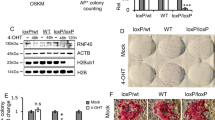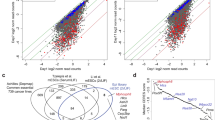Abstract
Cells of early mammalian embryos have the potential to develop into any adult cell type, and are thus said to be pluripotent. Pluripotency is lost during embryogenesis as cells commit to specific developmental pathways. Although restriction of developmental potential is often associated with repression of inappropriate genetic programmes1, the role of epigenetic silencing during early lineage commitment remains undefined. Here, we used mouse embryonic stem cells to study the function of epigenetic silencing in pluripotent cells. Embryonic stem cells lacking Mbd3 — a component of the nucleosome remodelling and histone deacetylation (NuRD) complex2,3 — were viable but failed to completely silence genes that are expressed before implantation of the embryo. Mbd3-deficient embryonic stem cells could be maintained in the absence of leukaemia inhibitory factor (LIF) and could initiate differentiation in embryoid bodies or chimeric embryos, but failed to commit to developmental lineages. Our findings define a role for epigenetic silencing in the cell-fate commitment of pluripotent cells.
This is a preview of subscription content, access via your institution
Access options
Subscribe to this journal
Receive 12 print issues and online access
$209.00 per year
only $17.42 per issue
Buy this article
- Purchase on Springer Link
- Instant access to full article PDF
Prices may be subject to local taxes which are calculated during checkout




Similar content being viewed by others
References
Busslinger, M., Nutt, S. L. & Rolink, A. G. Lineage commitment in lymphopoiesis. Curr. Opin. Immunol. sx 151–158 (2000).
Wade, P. A. et al. Mi-2 complex couples DNA methylation to chromatin remodelling and histone deacetylation. Nature Genet. 23, 62–66 (1999).
Zhang, Y. et al. Analysis of the NuRD subunits reveals a histone deacetylase core complex and a connection with DNA methylation. Genes Dev. 13, 1924–1935 (1999).
Hendrich, B. et al. Closely related proteins MBD2 and MBD3 play distinctive but interacting roles in mouse development. Genes Dev. 15, 710–723. (2001).
Takahashi, K., Mitsui, K. & Yamanaka, S. Role of ERas in promoting tumour-like properties in mouse embryonic stem cells. Nature 423, 541–545 (2003).
Hendrich, B. & Bird, A. Identification and characterization of a family of mammalian methyl-CpG binding proteins. Mol. Cell. Biol. 18, 6538–6547 (1998).
Bortvin, A. et al. Incomplete reactivation of Oct4-related genes in mouse embryos cloned from somatic nuclei. Development 130, 1673–1680 (2003).
Saitou, M., Barton, S. C. & Surani, M. A. A molecular programme for the specification of germ cell fate in mice. Nature 418, 293–300 (2002).
Sato, M. et al. Identification of PGC7, a new gene expressed specifically in preimplantation embryos and germ cells. Mech. Dev. 113, 91–94 (2002).
Huang, J., Durum, S. K. & Muegge, K. Cutting edge: histone acetylation and recombination at the TCRγ locus follows IL-7 induction. J. Immunol. 167, 6073–6077 (2001).
Martin, G. R. & Evans, M. J. Differentiation of clonal lines of teratocarcinoma cells: formation of embryoid bodies in vitro. Proc. Natl Acad. Sci. USA 72, 1441–1445 (1975).
Doetschman, T. C. et al. The in vitro development of blastocyst-derived embryonic stem cell lines: formation of visceral yolk sac, blood islands and myocardium. J. Embryol. Exp. Morphol. 87, 27–45 (1985).
Beddington, R. S. & Robertson, E. J. An assessment of the developmental potential of embryonic stem cells in the midgestation mouse embryo. Development 105, 733–737 (1989).
Tanaka, S. et al. Promotion of trophoblast stem cell proliferation by FGF4. Science 282, 2072–2075 (1998).
Hendrich, B. & Tweedie, S. The methyl-CpG binding domain and the evolving role of DNA methylation in animals. Trends Genet. 19, 269–277 (2003).
Saito, M. & Ishikawa, F. The mCpG-binding domain of human MBD3 does not bind to mCpG but interacts with NuRD–Mi2 components HDAC1 and MTA2. J. Biol. Chem. 277, 35434–35439 (2002).
Li, L. et al. Distinct GATA6- and laminin-dependent mechanisms regulate endodermal and ectodermal embryonic stem cell fates. Development 131, 5277–5286 (2004).
Ying, Q. L. et al. Conversion of embryonic stem cells into neuroectodermal precursors in adherent monoculture. Nature Biotechnol. 21, 183–186 (2003).
Ying, Q. L., Nichols, J., Evans, E. P. & Smith, A. G. Changing potency by spontaneous fusion. Nature 416, 545–548 (2002).
Niwa, H., Burdon, T., Chambers, I. & Smith, A. Self-renewal of pluripotent embryonic stem cells is mediated via activation of STAT3. Genes Dev. 12, 2048–2060 (1998).
Duval, D., Reinhardt, B., Kedinger, C. & Boeuf, H. Role of suppressors of cytokine signaling (Socs) in leukemia inhibitory factor (LIF) -dependent embryonic stem cell survival. FASEB J. 14, 1577–1584 (2000).
Tam, P. P. & Rossant, J. Mouse embryonic chimeras: tools for studying mammalian development. Development 130, 6155–6163 (2003).
Epping, M. T. et al. The human tumor antigen PRAME is a dominant repressor of retinoic acid receptor signaling. Cell 122, 835–847 (2005).
Chambers, I. et al. Functional expression cloning of nanog, a pluripotency sustaining factor in embryonic stem cells. Cell 113, 643–655 (2003).
Smith, A. G. Culture and differentiation of embryonic stem cells. J. Tiss. Cult. Meth. 13, 89–94 (1991).
Niwa, H. et al. Phenotypic complementation establishes requirements for specific POU domain and generic transactivation function of Oct-3/4 in embryonic stem cells. Mol. Cell. Biol. 22, 1526–1536 (2002).
Kawasaki, H. et al. Induction of midbrain dopaminergic neurons from ES cells by stromal cell-derived inducing activity. Neuron 28, 31–40 (2000).
Iscove, N. N. et al. Representation is faithfully preserved in global cDNA amplified exponentially from sub-picogram quantities of mRNA. Nature Biotechnol. 20, 940–943 (2002).
Morrisey, E. E., Ip, H. S., Lu, M. M. & Parmacek, M. S. GATA-6: A zinc finger transcription factor that is expressed in multiple cell lineages derived from lateral mesoderm. Dev. Biol. 177, 309–322 (1996).
Hebert, J., Boyle, M. & Martin, G. mRNA localization studies suggest that murine FGF-5 plays a role in gastrulation. Development 112, 407–415 (1991).
Wilkinson, D. G., Bhatt, S. & Herrmann, B. G. Expression pattern of the mouse T gene and its role in mesoderm formation. Nature 343, 657–659 (1990).
Gibson–Brown, J. J., I–Agulnik, S, Silver, L. M. & Papaioannou, V. E. Expression of T-box genes Tbx2-Tbx5 during chick organogenesis. Mech. Dev. 74, 165–169 (1998).
Kaipainen, A. et al. Expression of the fms-like tyrosine kinase 4 gene becomes restricted to lymphatic endothelium during development. Proc. Natl Acad. Sci. USA 92, 3566–3570 (1995).
Jackson, M. et al. Severe global DNA hypomethylation blocks differentiation and induces histone hyperacetylation in embryonic stem cells. Mol. Cell. Biol. 24, 8862–8871 (2004).
Acknowledgements
We are grateful to M. Osawa and S. Nishikawa for instruction on the single-cell cDNA amplification technique. We also thank J. Back and R. Wilkie for technical assistance; R. McLay, G. Russell and J. Agnew for chimaera production; and A. Smith, I. Chambers, T. Kunath, J. Kawaguchi and N. Reynolds for advice, discussions and comments on the manuscript. K.K. was the recipient of a postdoctoral fellowship from the Japanese Society for the Promotion of Science, and I.M.C. was the recipient of a University of Edinburgh School of Biological Sciences PhD studentship. This work was funded by the Wellcome Trust, the UK Medical Research Council, and Biotechnology and Biological Sciences Research Council (BBSRC) UK–Japan Partnering Award.
Author information
Authors and Affiliations
Corresponding author
Ethics declarations
Competing interests
The authors declare no competing financial interests.
Supplementary information
Supplementary Information
Supplementary figures S1, S2 and S3 plus Supplementary table S1 (PDF 399 kb)
Rights and permissions
About this article
Cite this article
Kaji, K., Caballero, I., MacLeod, R. et al. The NuRD component Mbd3 is required for pluripotency of embryonic stem cells. Nat Cell Biol 8, 285–292 (2006). https://doi.org/10.1038/ncb1372
Received:
Accepted:
Published:
Issue Date:
DOI: https://doi.org/10.1038/ncb1372
This article is cited by
-
Dissecting the roles of MBD2 isoforms and domains in regulating NuRD complex function during cellular differentiation
Nature Communications (2023)
-
Live-cell three-dimensional single-molecule tracking reveals modulation of enhancer dynamics by NuRD
Nature Structural & Molecular Biology (2023)
-
Nucleosome remodeling and deacetylation complex and MBD3 influence mouse embryonic stem cell naïve pluripotency under inhibition of protein kinase C
Cell Death Discovery (2022)
-
SS18 regulates pluripotent-somatic transition through phase separation
Nature Communications (2021)
-
Histone deacetylases, Mbd3/NuRD, and Tet2 hydroxylase are crucial regulators of epithelial–mesenchymal plasticity and tumor metastasis
Oncogene (2020)



